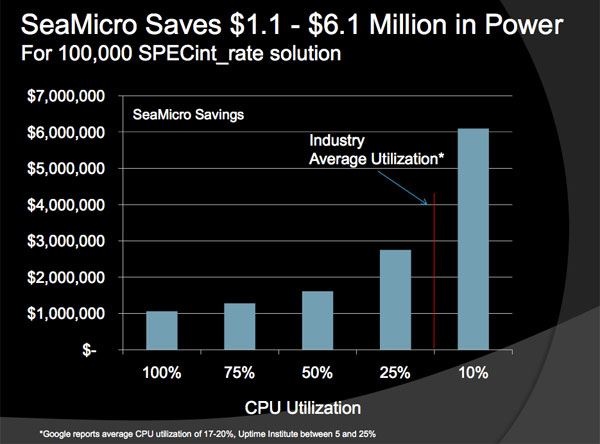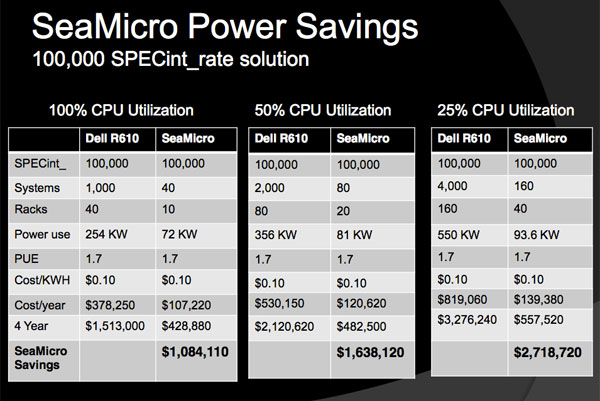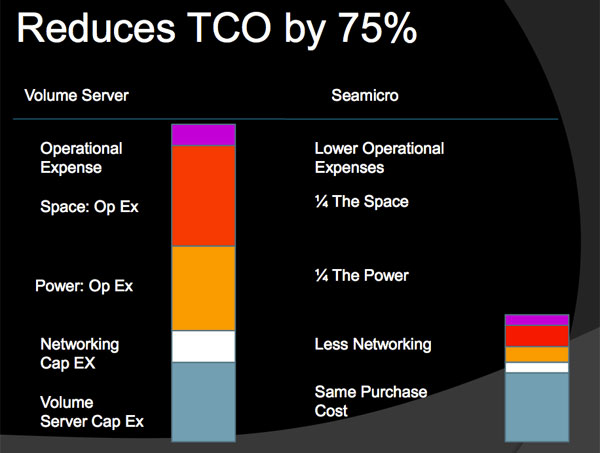SeaMicro Announces SM10000 Server with 512 Atom CPUs and Low Power Consumption
by Anand Lal Shimpi on June 14, 2010 1:38 PM EST- Posted in
- IT Computing
- CPUs
- SeaMicro
Final Words
The base configuration of the SeaMicro SM10000 comes with 512 Atom servers, 1TB of DDR2 memory and no storage. SeaMicro charges $139,000 per SM10000 in this configuration.
It is easy to see how this technology might scale. Simple drop the number of cards used in the server and now you have a lower end configuration. SeaMicro needs to be able to make enough revenue to support its business model so I wouldn’t expect any ultra cheap Atom servers out of the company anytime soon. Scaling down appears to be a top priority, although scaling up is also a possibility.
The limitations are of course numerous. There’s no official Windows support, so this for Linux only deployment. Each server is limited in performance not only by the CPU but also by the memory capacity (2GB). There’s no ECC, no real RAID support (other than striping). It’s very clear that the SM10000 can potentially serve one specific niche very well: a setup with tons of servers that have low CPU usage requirements.
The benefits are clear. If you’re running tons of servers that are mostly idle, the SM10000 could save you boatloads on power. By stripping out most of the components on the motherboard and simplifying each server down to something that consumes roughly 4W of power, SeaMicro does have a very valid solution to the power problem in data centers.

The power savings scale up tremendously. On a large scale the cost of running servers really boils down to hardware, then software then power in order of increasing cost. If you’re running tens of thousands of servers, power consumption becomes a real problem. And this is where SeaMicro is most effective:

I suspect that anyone faced with rising data center power costs will be at least interested in what SeaMicro has to offer.
The obvious argument against the SeaMicro approach is virtualization. Combine multiple servers into one beefy Xeon or Opteron machine and then you start to use those processors at their peak efficiency by keeping them loaded most of the time.

It’s difficult to tell based on a press presentation how well the SeaMicro solution fares against a beefy Xeon server running hundreds of VMs. I don’t doubt that it is a lower power solution, the question is whether or not the performance characteristics work with your specific needs.
From where I stand, the SM10000 looks like the type of product that if you could benefit from having it, you’ve been waiting for something like it. In other words, you will have been asking for something like the SM10000 for quite a while already. SeaMicro is simply granting your wish.










53 Comments
View All Comments
Samus - Wednesday, June 16, 2010 - link
Windows servers account for over half the corporate server market. The rest of the market is filled with a clusterfuck of strange shit like Mac servers, Linux servers running probably close to a dozen different ISA's and then you've got Sun and some other niche' products.This is ALREADY a niche' product. Why would you further convolute the market segment by making a niche' product a niche' product. They're doing the right thing making it compatible with the MAJORITY. An ARM (or niche') product can come if and when this thing successfully makes money.
bmullan - Monday, July 19, 2010 - link
I've been using the ARM based Marvel electronic's $99 "Sheeva" Plug Computers for over a year now. I get mine from GlobalScale.They come with linux (ubuntu) preinstalled but you can install other linux flavors.
I pulled and installed dozens of applications down to those little 4.5 W computers and they all worked fine.
I had several so some were running apache web server apps, some were setup as SAMBA servers for sharing music, videos within my home etc. I'm sure there are problems I've just not encountered but as I said they worked great.
ARMs don't have math co-processing so there are some things they can't do or do well.
But those little $99 Plug computers work great.
I just ordered a couple new models that while still 4.5 Watts, now support -
Linux Kernel 2.6.32
Wi-Fi 802.11b/g
Bluetooth: 2.1 / EDR
U-SNAP I/O
DDR2 800MHz, 16-bit bus
512MB 16bit DDR2 @ 800MHz data rate
NAND FLASH Controller, 8-bit bus
512MB NAND FLASH: 4Gb x8, direct boot
128-bit eFuse Memory
7x GPIOs for user application- 5 with 3.3V I/O, 2 with 1.8V I/O
1x eSATA 2.0 port -3Gbps SATAII
2x USB 2.0
1x Internal MicroSD Socket for Optional Kernel System
1x External MicroSD Socket
RTC w/Battery
Optional with SPI Flash + SD card boot up
UBIFS Flash file system support
NAND Flash boot up
esata
RagingDragon - Tuesday, August 24, 2010 - link
Some ARM implementations have hardware floating point and/or SIMD units, others don't.Those plug computers look interesting, though I haven't dug into hardware specs to see if they have hardware floating point and/or SIMD.
Thog - Tuesday, June 15, 2010 - link
ECC would be nice for a server, but depending on what you're doing, flops are nowhere near as important as concurrency. I'd rather have a box that can run Solaris or Linux i386 out-of-the-box, including applications already compiled for it.nafhan - Wednesday, June 16, 2010 - link
Using Atom instead of ARM makes this almost a drop in replacement for the Xeon/Opteron boxes they are talking about replacing. Once you switch away from x86 you're talking about a lot more work and a lot more risk for enterprise customers to adopt this. An enterprise customer will appreciate the decreased risk the ability to fall back to his old hardware allows. Changing the software stack makes switching back and forth much more difficult.surt - Monday, June 14, 2010 - link
Arm doesn't run x86 workloads very well, does it?loknar28 - Monday, June 14, 2010 - link
They could always make a server version of Windows Mobile, lol.piroroadkill - Tuesday, June 15, 2010 - link
But we're talking server workloads. A server of this scale is probably running Linux and anything you could compile for ARM anyway.Shining Arcanine - Tuesday, June 15, 2010 - link
Exactly what is a x86 workload?GeorgeH - Monday, June 14, 2010 - link
It was inevitable that the first Borg Cube's hive mind would be x86 compliant.Resistance is futile, people.